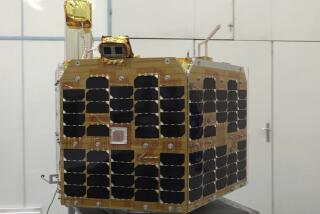$140-Million Satellite Lost : Big Blow to Commercial Space Effort
CAPE CANAVERAL, Fla. — An uninsured $140-million communications satellite apparently failed to separate from its Titan 3 booster rocket after launch today and was feared lost in space in a potential disaster for America’s fledgling commercial space program.
If the Intelsat 6 spacecraft cannot be salvaged, the 118-nation International Telecommunications Satellite Organization would be faced with a $270-million loss in the second major commercial space disaster in a row since the Feb. 22 explosion of a French Ariane 4 rocket that destroyed two Japanese satellites.
Officials with Titan-builder Martin Marietta Astronautics Group of Denver initially said the company’s rocket performed flawlessly. Later in the day, however, they said the costly satellite apparently did not separate from the rocket’s second stage as planned 25 minutes after launch.
“Initial review of data suggests separation did not occur,” a company spokeswoman said.
The satellite cannot function properly in its current low orbit, and unless engineers figure out some way to separate the spacecraft--if that is, in fact, the problem--Intelsat officials will be threatened with a total loss and a possible re-entry into Earth’s atmosphere.
But with a news blackout in effect at Intelsat headquarters in Washington, the status of the satellite, built to carry up to 120,000 transatlantic telephone calls and three television channels, was not immediately known.
The $130-million Titan 3 rocket, the most powerful U.S. booster ever built as a commercial venture, blasted off from Cape Canaveral Air Force Station at 6:53 a.m. and about 10 minutes later the second stage carrying the Intelsat 6 satellite was in its planned preliminary orbit.
Martin Marietta officials said at first that data radioed to Earth from the Titan second stage showed the drum-shaped satellite had been ejected into space, completing the launch phase of the mission.
But later they revised their statement and said the satellite was apparently never released from the rocket.
In any case, when the satellite sailed back into radio contact over Hawaii a little more than an hour after launch, engineers on the ground were unable to detect any signals from the costly spacecraft.
The four-story-tall Intelsat 6 was placed into an egg-shaped orbit by its Titan 3 booster with a low point of about 109 miles and a high point of 247 miles.
To reach its operational altitude of 22,300 miles above the Equator, Intelsat 6 must first separate from the Titan 3 second stage before a series of on-board rocket firings starting with a critical “burn” 70 minutes after liftoff when a solid-fuel booster was scheduled to ignite.
Frederick Ormsby, spacecraft mission director for Intelsat, said the not-for-profit international consortium had not insured the satellite. Insuring satellites is prohibitively high, especially since last month’s explosion of the Ariane rocket.
The unmanned Ariane rocket carrying two Japanese communications satellites blew apart over the Atlantic shortly after taking off from Kourou, French Guiana.
More to Read
Sign up for Essential California
The most important California stories and recommendations in your inbox every morning.
You may occasionally receive promotional content from the Los Angeles Times.









